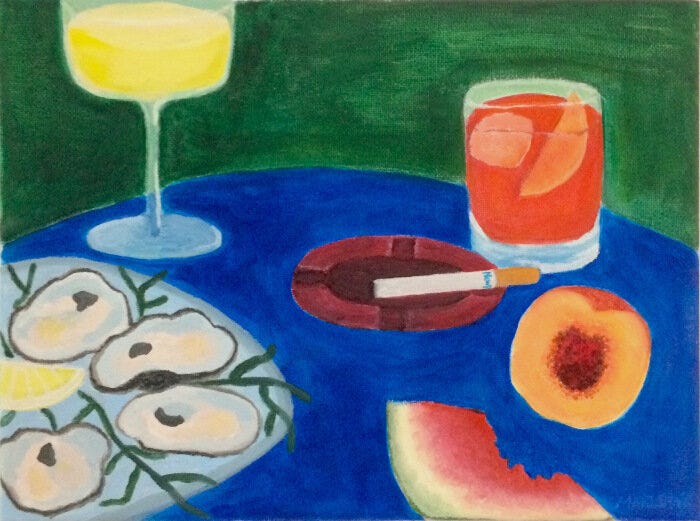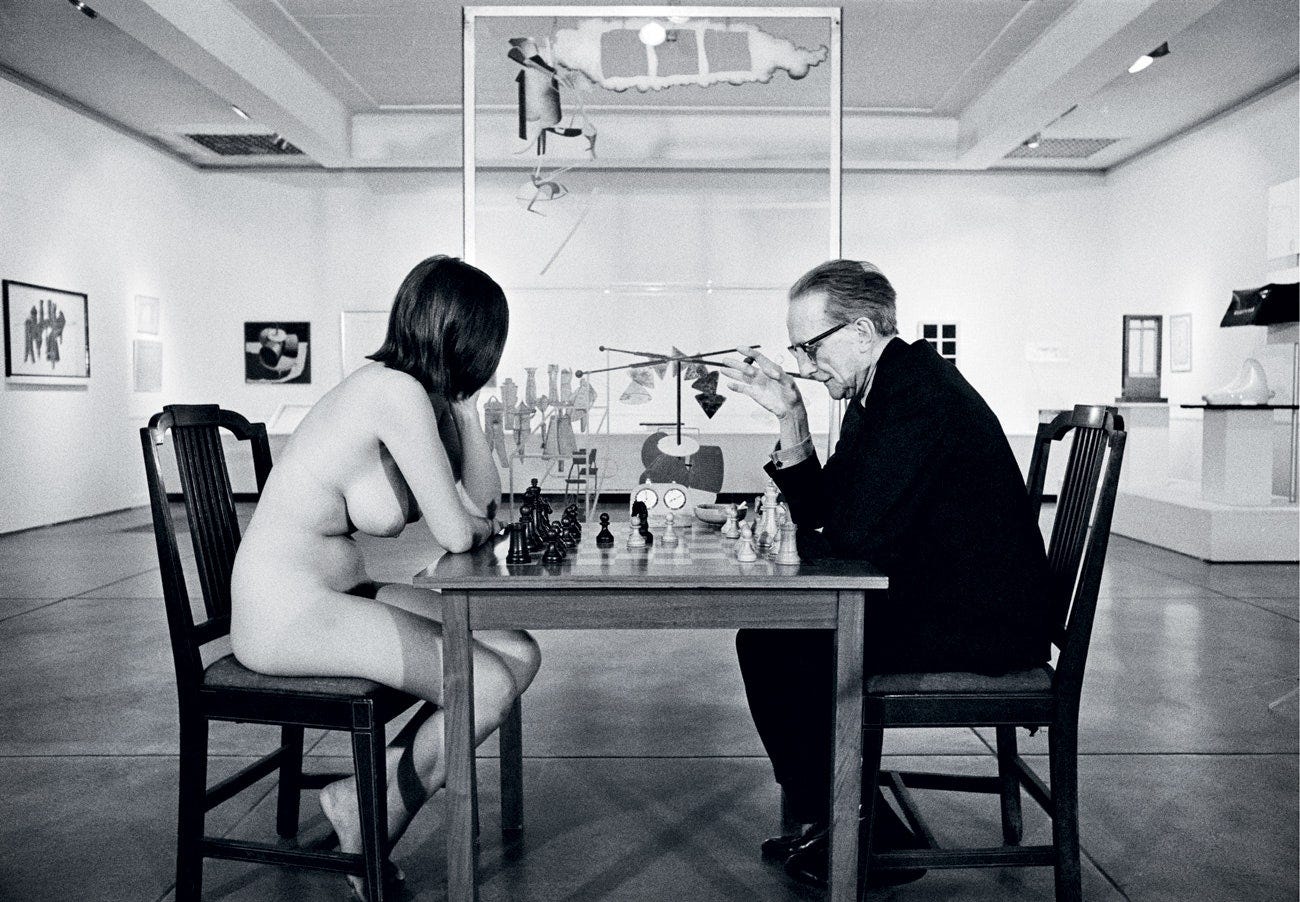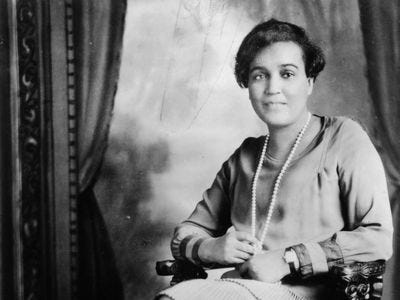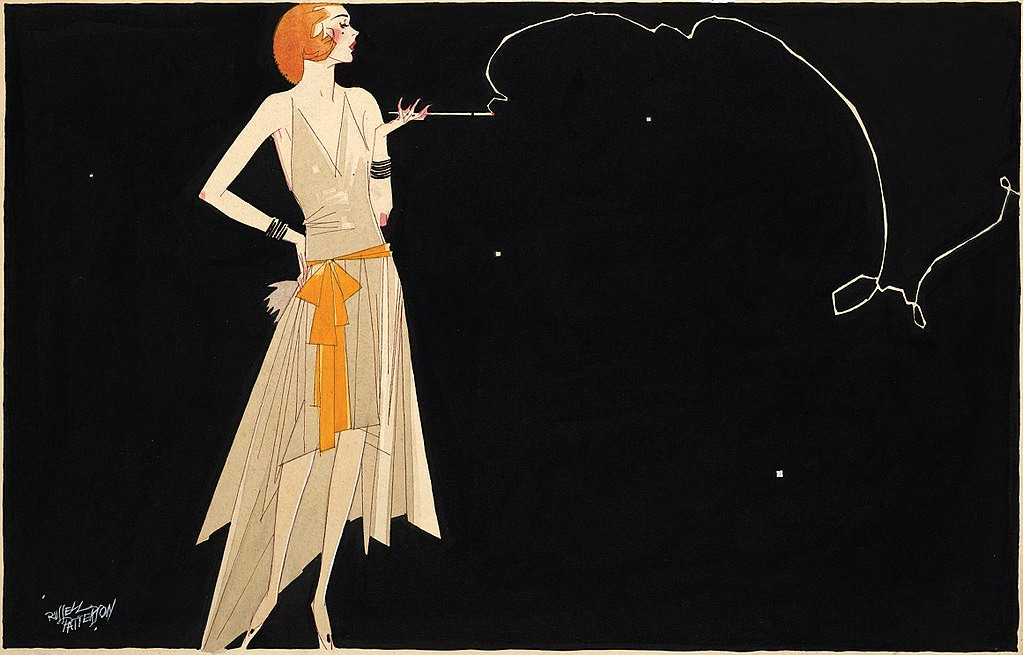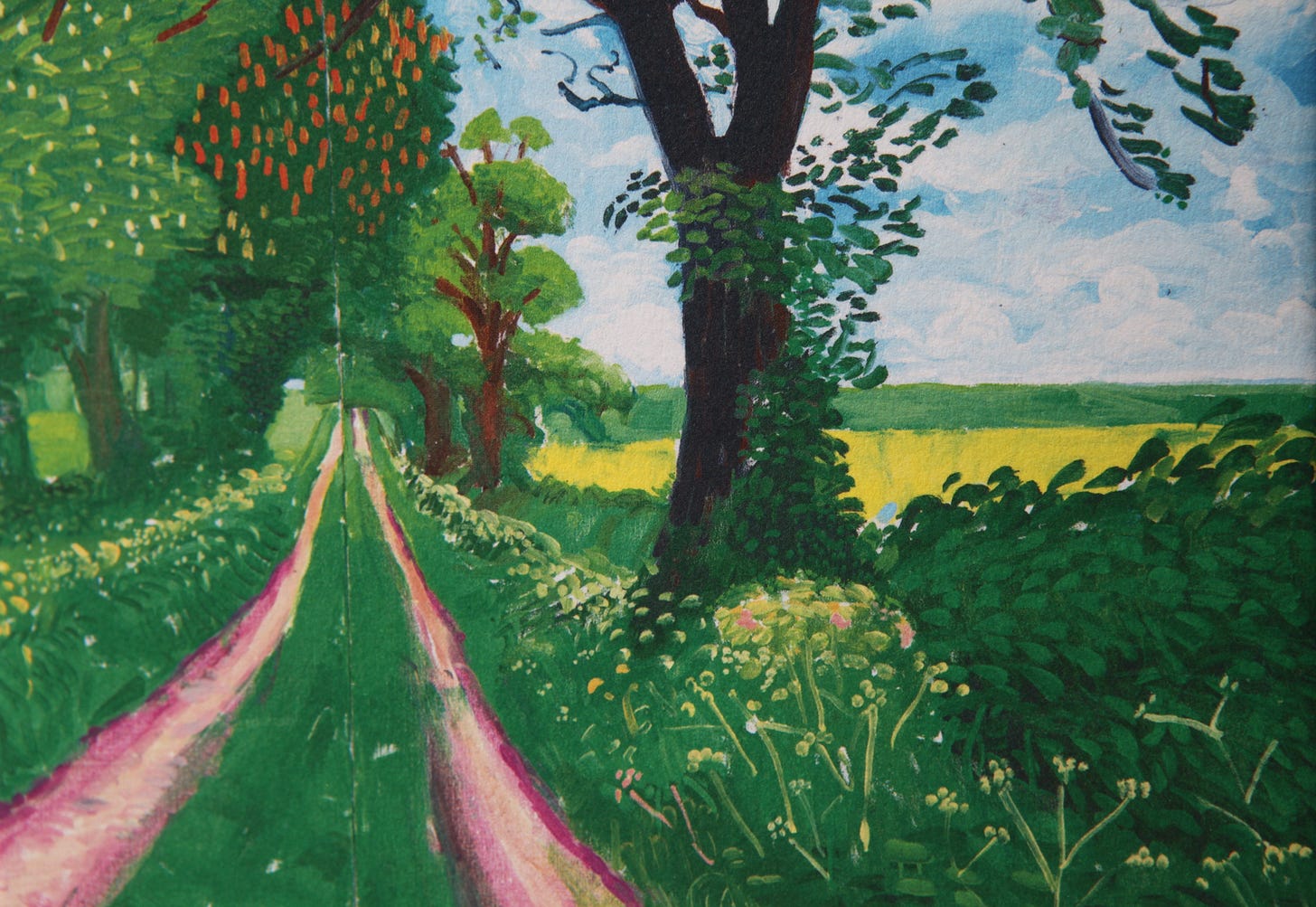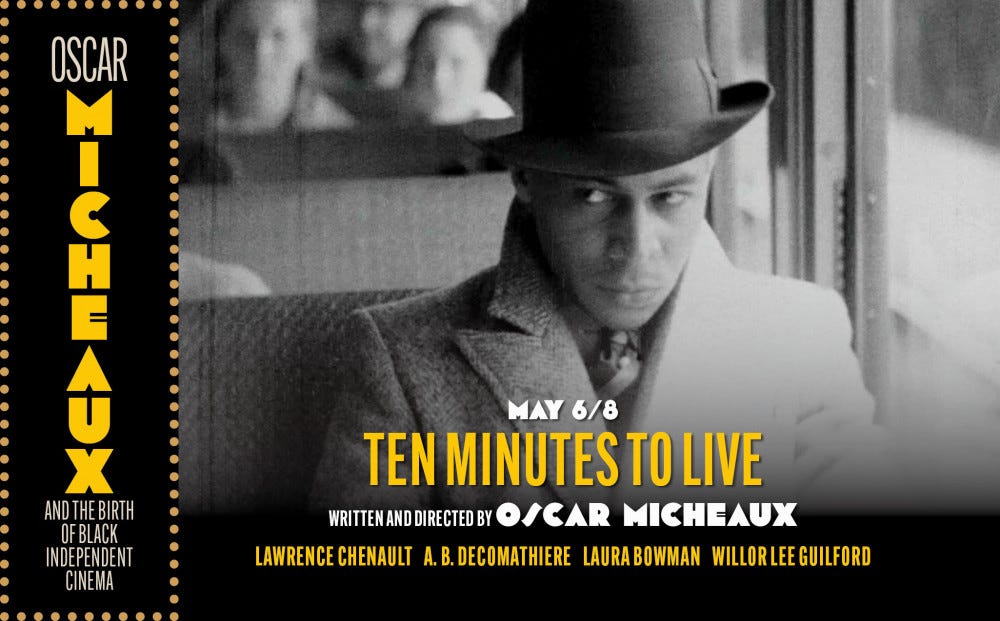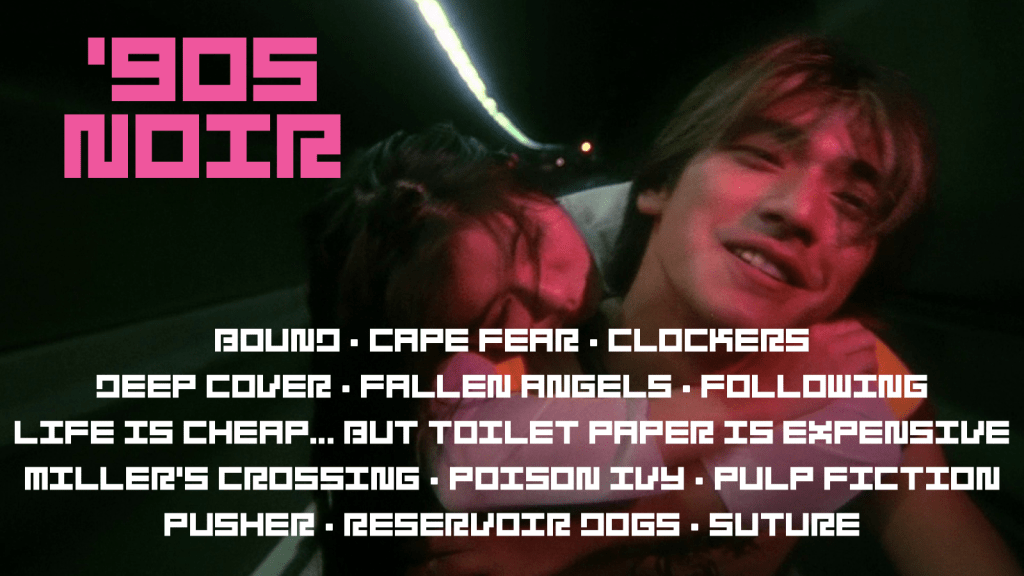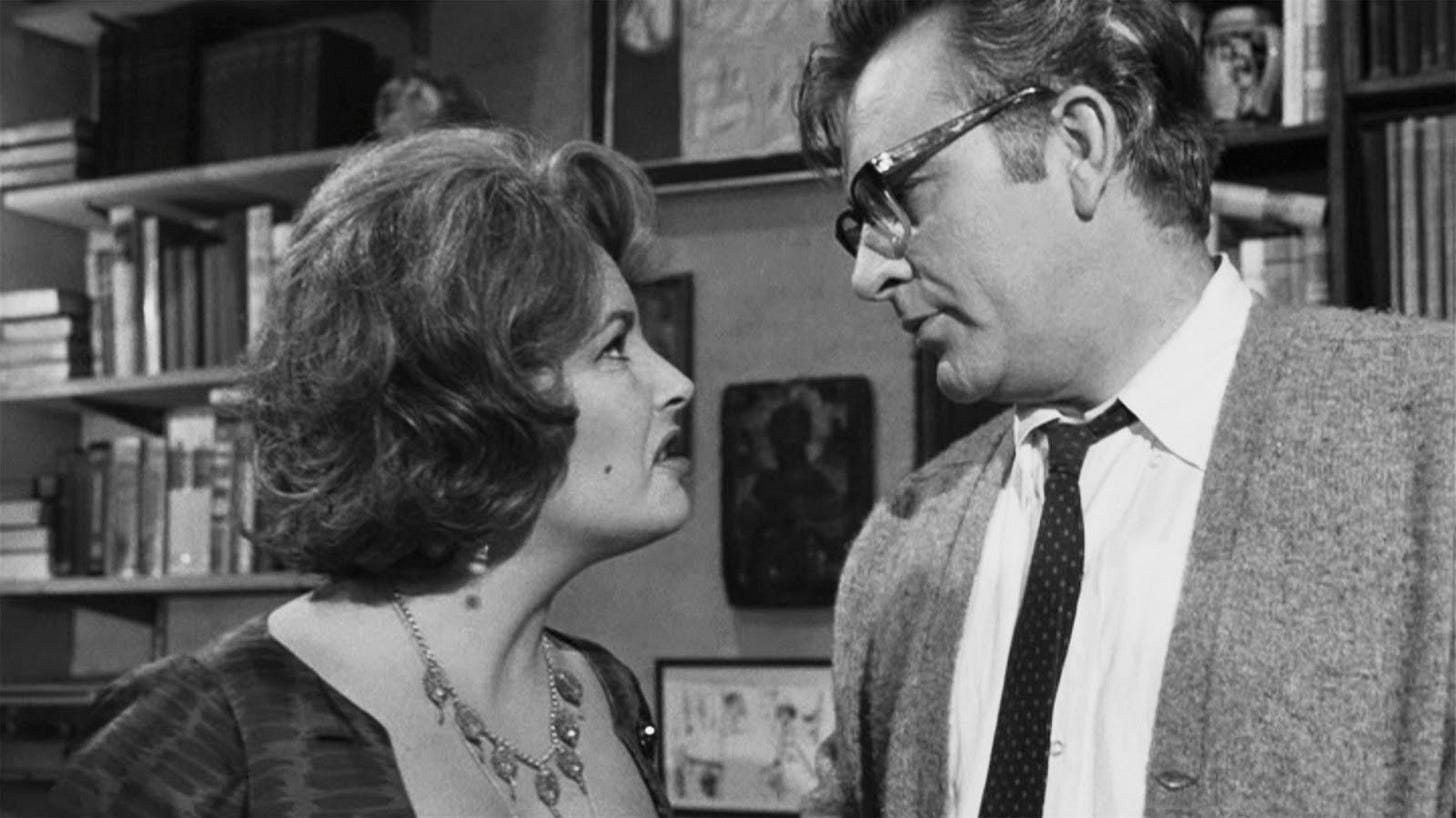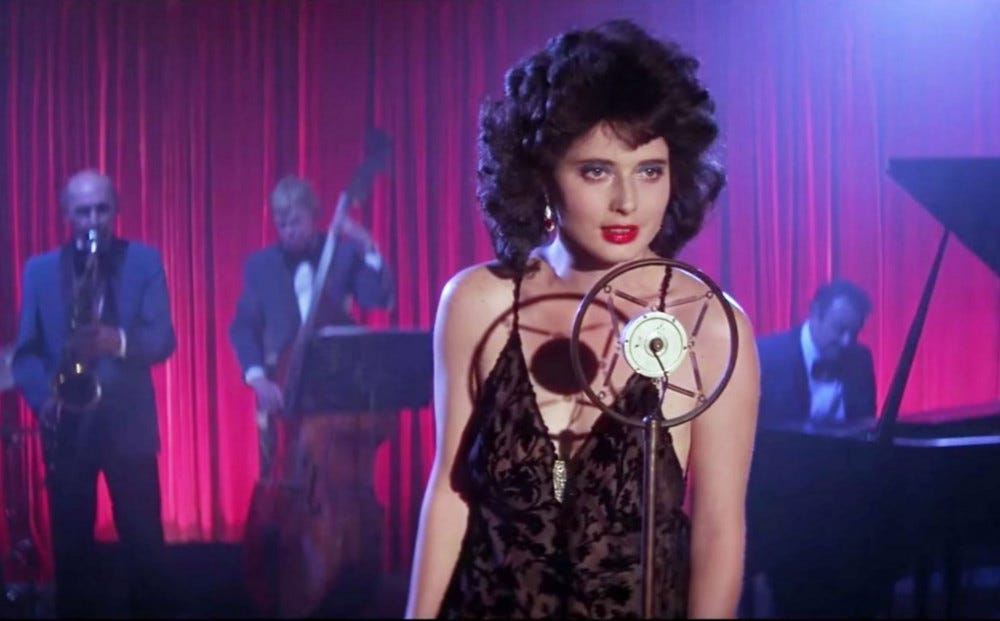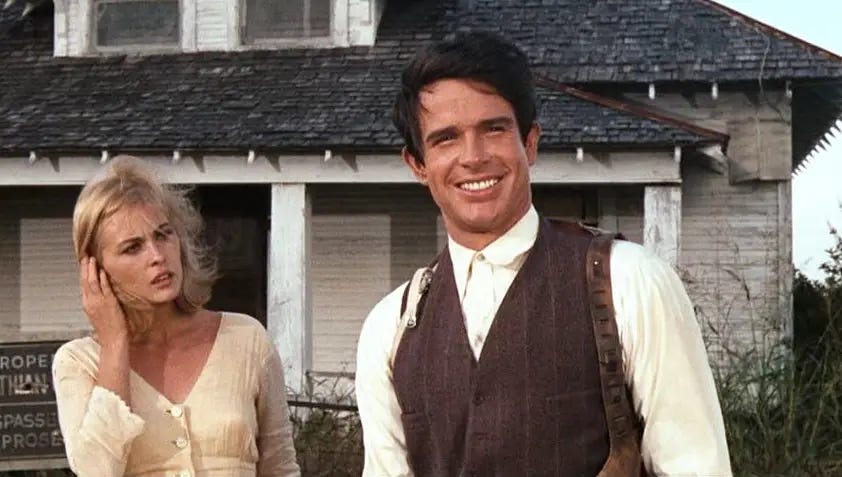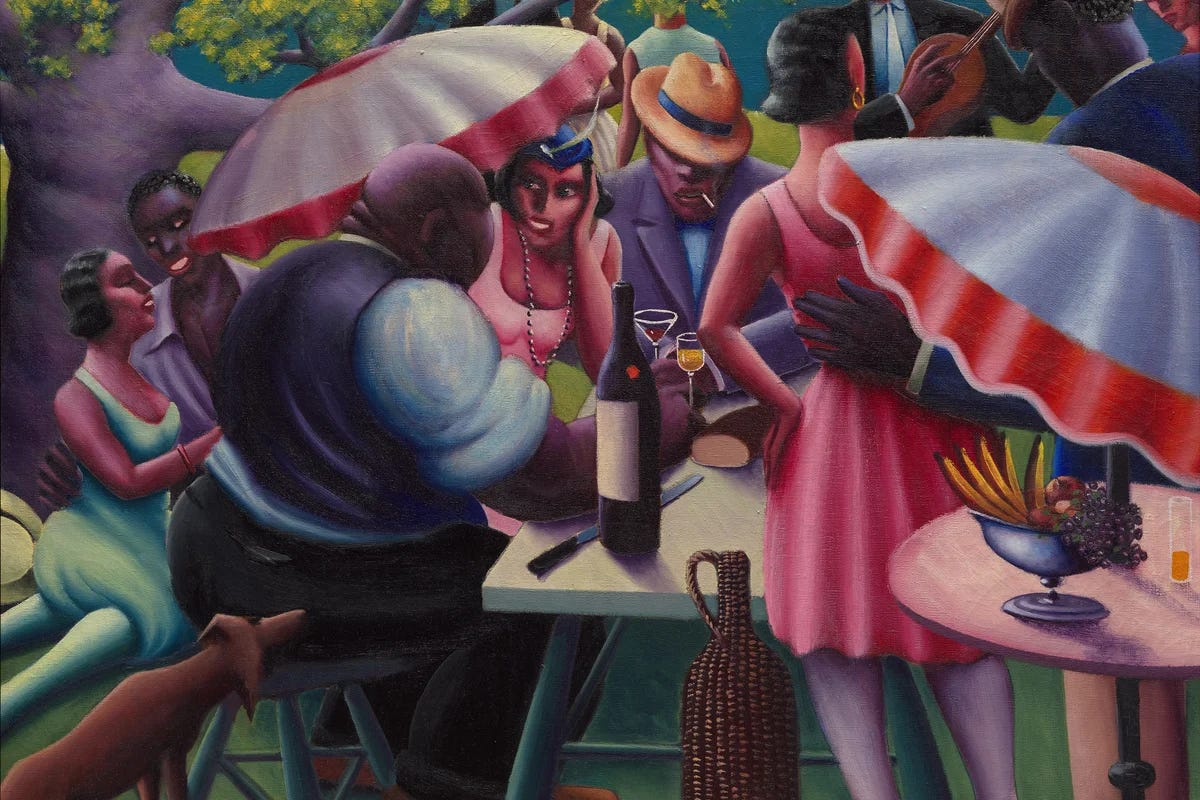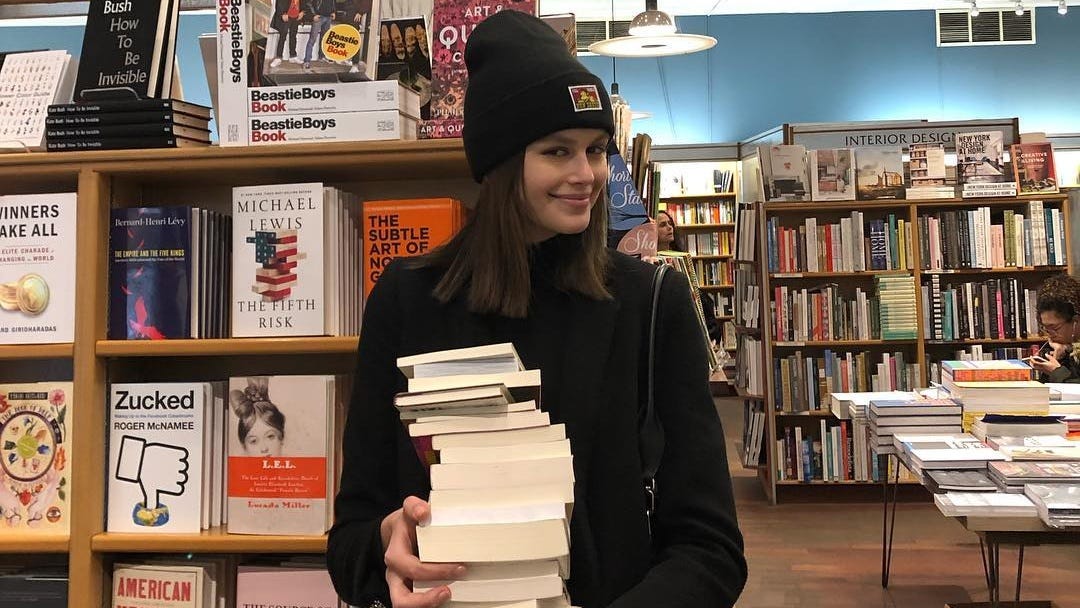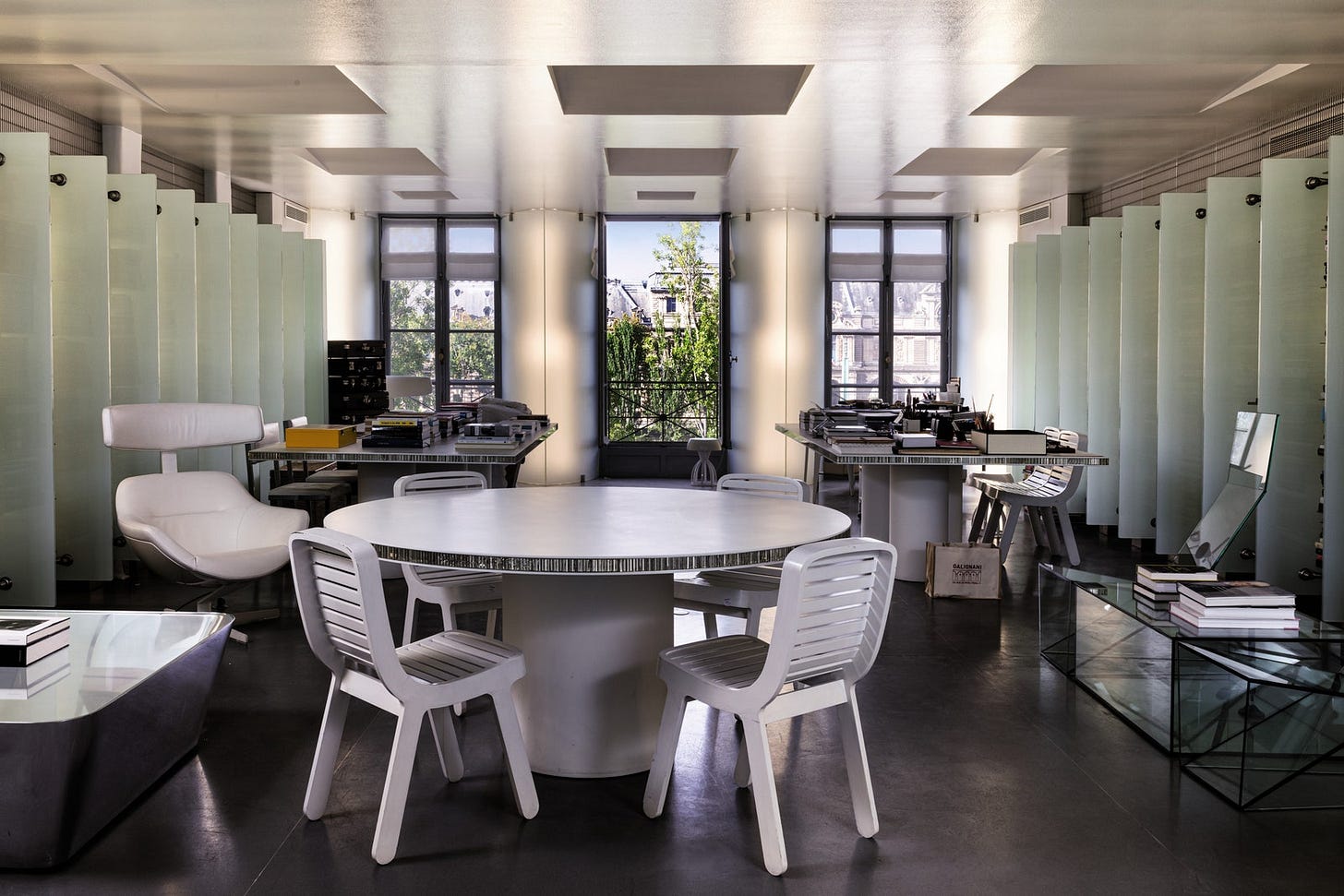Finally, spring is really here! May is one of my favorite months, a hopeful one marked by the feeling that summer’s creeping just around the corner — and an especially lovely time to be a New Yorker.
With that spirit in mind, recommendations for the month ahead include:
May Book Selections
Happy Hour by Marlowe Granados (2020) — An ode to the pursuit of pleasure, Marlowe Granados’s debut follows 21-year-old Isa and her best friend, Gala, as they party and penny pinch their way from Bed-Stuy to the Upper East Side and back again. Set in the summer of 2013 and written in the form of diary entries from Isa, the novel captures the glamour of girlhood, the endless possibility of youth. As author Alexandra Kleeman puts it: “Reading Marlowe Granados’s Happy Hour feels like eating a shimmering, intoxicating slice of the best summer of your life, a sort of Proustian cookie that transports you back not to your childhood but to the time when you looked best in cut-off shorts and felt like your heart was made of rubber.”
The novel declares its tone from its first line, with Isa explaining: “My mother always told me that to be a girl one must be especially clever. Before landing at JFK, I had three Bloody Marys and an extra piece of cake that fell apart in my mouth. A person should never take on a city with an empty stomach, and I am always hungry. Leaving London didn’t bother me much because one should always be making moves. When asked, ‘What made you come to London?’ I would say, ‘I didn’t want to go home.’ That, to me, is always enough.” Per Vulture: “The protagonists of Happy Hour fall into a clear literary tradition. They owe something to Holly Golightly and Eliza Doolittle, as well as the heroines of Elaine Dundy, Edith Wharton, and Anita Loos, whose romantic exploits are fortified by sardonic observations of the moneyed social planes they move in. Isa even talks like them; indeed, Happy Hour is practically written in a transatlantic accent…[Granados] jokes that Isa’s distinctive, Old Hollywood way of speaking is really her own ‘after three drinks.’”
As the girls’ cash begins to dwindle, the sheen tinting their adventures starts to fade. In her review for Coveteur, my friend Ama (hi, Ama!) writes: “The novel follows a structure similar to that of a fête. When an evening begins at happy hour, who knows where the night could take you? But what happens when you stay at a party a little too long; when you've had one too many spicy mezcal drinks? As the night progresses, party-goers typically begin to unravel, revealing their true selves. No one wants to be the last one standing, forced to gaze upon their vices in broad daylight. But that's what begins to happen in Happy Hour; the lightness that encompasses the opening of the novel starts to dim. Granados does a masterful job at touching on race and class without hitting the reader over the head with overused tropes or stale language. The reader becomes aware of the messy dynamics between Isa, who is a woman of color, and Gala, who is white, through their interactions — it's never stated for the reader explicitly. During a heated moment in the novel, Isa says to Gala, ‘Don't forget...you're the one who has always been allowed to act out...it's a luxury you've been given. People always made me responsible for what you did.’”
Slow Days, Fast Company by Eve Babitz (1977) — Eve Babitz’s iconic Southern California essay collection opens with the following: “This is a love story and I apologize; it was inadvertent. But I want it clearly understood from the beginning that I don’t expect it to turn out well…Since it’s impossible to get this one I’m in love with to read anything unless it’s about or to him, I’m going to riddle this book with Easter Egg italics so that this time it won’t take him two and half years to read my book like it did the first one. The seduction of a non-reader is how I plan to tie up L.A.. Virginia Woolf said that people read fiction the same way they listen to gossip, so if you’re reading this at all then you might as well read my private asides written so he’ll read it. I have to be extremely funny and wonderful around him just to get his attention at all and it’s a shame to let it all go for one person.”
The subsequent writings meander across and beyond Los Angeles; to Bakersfield (“There was no extra energy in those women beyond their children or their particular geography. There was no energy for humor or wit, and I wondered at my friends in L.A. who were always brimming over with spare words and bright phrases.”), Palm Springs (“I wanted to write a story about Palm Springs that was going to be sexy. I wanted a story with peace in it, for god’s sake. Now I was stuck with this broken romance: Shawn kissing my foot instead of my mouth.”), and Emerald Bay (“Dead leaves must have been removed from trees before they dried up so that no one would ever have to think about things drying up and falling to the ground in Emerald Bay. No unpleasant notions.”). Epigraphs to the object of Babitz’s affection, Paul Ruscha (yes, brother of Ed), precede each essay (“Darling: I know you don’t are about the art of the novel but you might like the part about Forest Lawn.”), creating a thematic through line. But each piece stands on its own, pierces the core of California’s cultural zeitgeist (“You can’t write a story about L.A. that doesn’t turn around in the middle or get lost.”).
I surprisingly haven’t written about Eve Babitz in past newsletters despite the fact that she’s one of my favorite authors — and my cat’s namesake. For those of you unfamiliar, Babitz grew up in Los Angeles in the 1950s and early 1960s, where she attended Hollywood High School. Her first shot of notoriety came in 1963 at age 20, when Time’s Julian Wasser photographed her playing chess in the nude with Marcel Duchamp at the Pasadena Art Museum, a move on Babitz’s part to make her married boyfriend, museum director — and former co-runner of Ferus Gallery, where Andy Warhol’s soup cans made their West Coast debut — Walter Hopps, jealous. She toggled between art world and music scene groupie, hooking up with everyone from Paul Ruscha to Jim Morrison (Per Eve’s gay frenemy Earl McGrath: “In every young man's life there is an Eve Babitz. It's usually Eve Babitz.”). She also created cover art for some of the most iconic musicians of the 1960s and 1970s, including Linda Ronstadt, The Byrds, and Buffalo Springfield.
All the while, Babitz recorded her misadventures in writing, and her career took a fortuitous turn when she befriended Joan Didion. In the early days of what would become a lifelong frenemyship, Didion advocated for Babitz’s work, leading to the publication of Eve’s Hollywood in 1974. Babitz’s writings trace the cultural evolution of Los Angeles from the 1960s through the 1990s in essay collections and novels including Sex and Rage (1979), L.A. Woman (1982), and Black Swans (1993); as Matthew Specktor puts it in his introduction to the New York Review Books reissue of Slow Days, Fast Company (1977): “I can think of no cultural artifact of any kind that better preserves Sunset Boulevard, circa 1974.”
In 1997, Babitz retreated from public life after accidentally dropping a lit match on her skirt, catching her stockings and skin on fire; then, as she grew older, Huntington’s Disease ate away at her mental acuity. She died in 2021. But prior to that, Babitz emerged at the nexus of a pop cultural renaissance in the late 2010s, after her books got reissued and garnered praise from the likes of Jia Tolentino and Zosia Mamet. Vanity Fair writer Lili Anolik wrote a retrospective piece on Babitz before eventually developing a full-blown biography, Hollywood’s Eve (2019), which Bret Easton Ellis describes as: “A gossipy and wonderful introduction to not only Eve Babitz and her somewhat tragic life…but the social history of Los Angeles in the 1960s and 1970s—[a] jeweled piece of pop culture.”
Where Didion takes a downbeat approach to unpacking Southern California culture, Babitz basks in her unabashed love of Los Angeles (“The Bloody Marys at Musso & Frank’s Restaurant are unparalleled in Western thought and can cure anything.”). In Slow Days, Fast Company, her most critically acclaimed work, Babitz writes: “I love L.A. The only time I ever go to Forest Lawn is when someone dies. A kid from New York once said: ‘Look. Which would you rather? To spend eternity looking out over these pretty green hills or in some overcrowded ghetto cemetery next to the expressway in Queens'?’ L.A. didn’t invent eternity. Forest Lawn is just an example of eternity carried to its logical conclusion. I love L.A. because it does things like that.”
There Is Confusion by Jessie Redmon Fauset (1924) — A lesser known novelist, poet, and editor, Jessie Redmon Fauset played a crucial role in the Harlem Renaissance (more on that in a bit) through her work with W. E. B. Du Bois’s The Crisis, the NAACP’s quarterly journal, and her commitment to portraying the emotional truth of Black life at the turn of the 20th Century.
Fauset began to write for The Crisis in 1912, contributing poems, essays, and reviews before stepping into the role of Literary Editor in 1919. She moved from Philadelphia to New York for the position. Per Poets.org (lol): “Fauset introduced then-unknown writers, including Countee Cullen, Langston Hughes, Claude McKay, and Anne Spencer, to a national audience. In his memoir The Big Sea, Hughes writes, ‘Jessie Fauset at The Crisis, Charles Johnson at Opportunity, and Alain Locke in Washington were the three people who midwifed the so-called New Negro literature into being. Kind and critical — but not too critical for the young — they nursed us along until our books were born.’” Living with her sister in Harlem, Fauset hosted salons that became a creative center for Black artists in and beyond the neighborhood.
In 1926, Fauset left The Crisis to become a high school French teacher in the Bronx. Between 1924 and 1933, she published four novels: There Is Confusion (1924), Plum Bun (1928), The Chinaberry Tree (1931), and Comedy, American Style (1933). Her marriage to businessman Herbert Harris in 1929, at age 47, initiated a move to New Jersey, then back to Philadelphia, where she lived until her death in 1961, at age 79.
Despite her significant contributions, Fauset remains an under-recognized figure in the grand scheme of the Harlem Renaissance as a result of her gender, something explored by Morgan Jerkins in a 2017 piece for The New Yorker. In the article, Jerkins quotes University of Wisconsin English professor Cherene Sherrard-Johnson, who observes: “Initially, Fauset’s work was dismissed as sentimental and Victorian, primarily because she dealt with ‘women’s issues,’ centering on the marriage plot.” But Fauset’s preoccupation with the marriage plot serves as a political act in and of itself through its prioritization of the personal, which inherently contains undercurrents of the political.
Her debut novel essentially teases out a love triangle. Per the back cover: “Set in early-twentieth-century New York City, There Is Confusion tells the story of three Black children: Joanna Marshall, a talented dancer willing to sacrifice everything for success; Maggie Ellersley, an extraordinarily beautiful girl determined to leave her working-class background behind; and Peter Bye, a clever would-be surgeon who is driven by his love for Joanna.” As Jerkins describes: “The novel raises questions that still feel urgent today: Does a black artist have to reflect the larger ideals of his or her community? Is individuality reserved for white people? These were questions that Fauset had asked herself.”
Ex-Wife by Ursula Parrott (1929) — Okay, I know you all are sick of me telling you to read this book (which, ICYMI, I reviewed back in November), but it really is the perfect May read IMO. One of my favorite scenes in the novel, which chronicles the adventures of twenty-something divorcée Patricia at the height of the Jazz Age, takes place at the Waldorf Astoria on an early summer evening. Lucia, Patricia’s bestie and roommate, prepares to escape to Europe for the summer with her new beau, and the two women sit down for their spin on the Last Supper.
Patricia narrates: “At the Waldorf, I wanted to tell her [Lucia] that I loved sharing an apartment with her, and that I liked her better than any woman I had ever known — but Lucia and I were inarticulate with each other about things like that. So we talked of places Lucia and Sam would visit, and things I wanted her to get me in Paris, and ate tomato en gelée, and lobster, and alligator pears — the preposterous sort of meal women order when they are dining together. Warm summer dusk deepened along the Avenue outside.” As I wrote back in November: “To me, this excerpt captures a familiar, late May feeling of summer descending on the city, a moment infused with knowledge of lonely months ahead as friends escape abroad.”
Spring by Ali Smith (2019) — I first discussed Ali Smith’s seasonal quartet in last September’s newsletter, lauding how the Scottish author “teas[es] out the sociopolitical landscapes of the 2010s and 2020s with starting immediacy. (For instance, Autumn, published in 2016, integrates Brexit, while Summer, which debuted in 2020, brings in the impact of COVID-19’s onset.)” I recommended starting Autumn back in September, reading Winter in December. Now that we’ve reached May, it’s the perfect time to start Spring, the quartet’s chronological third novel, if you’ve been following along with this series.
Formally inventive and narratively splintered — hallmarks of Smith’s style —, Spring thematically centers on immigration. It follows three central characters — Richard Lease, an older filmmaker coping with the loss of his best friend and looking for escape; Brit, a Immigration Removal Center employee; and Florence, a schoolgirl staging IRC security breaches — as they board a northbound train to Scotland, their paths fated to converge.
Per The New York Times in 2019: “As raw as this morning’s Twitter rant and as lasting and important as — and I say this neither lightly nor randomly — Ulysses…Spring, set largely in October of 2018 (yes, October as in last autumn; yes, of 2018, as in just a few months ago), is the angriest, the most cathartic and despairing, of the three. It’s consumed with Brexit and refugee detention and social media and Trump…It’s also a psychological novel…straddling immediacy and permanence, the personal as well as the scope of a world tilting toward disaster…literature of an indefinable and baffling era.” From the vantage point of even five years’ time, Spring strikes me as an era bottled by way of text, a reminder of the concurrent temporality and universality of our sociopolitical struggles.
Upcoming Content to Consume
Film Forum: Oscar Micheaux and the Birth of Black Independent Cinema (Dates: 5.3-5.9) — Born in 1884, Oscar Micheaux began his career as a novelist before emerging as one of the most prolific filmmakers of the early 20th Century. Much like Jessie Redmon Fauset’s fiction, Micheaux’s filmography distills the concerns of contemporary Black life during a crucial moment of social change. Straddling silent and sound, his body of work consists of over 40 films, 17 of which will screen at Film Forum this month.
Metrograph’s ‘90s Noir Series (Dates: 5.3-5.26) — This weekend, Metrograph kicks off a series dedicated to film noir’s greatest decade since its Bogie and Bacall-era heyday. Per the theater’s site: “Though the narrative and stylistic conceits that make up film noir never really left cinema, they had their best decade since the 1940s in the years of grunge, gangsta rap, the Gulf War, and William Jefferson Clinton. With ’90s Noir, explore the depressive, desperate cinematic underbelly of the decade’s official optimism and prosperity, with highlights from the heyday of the erotic thriller as well as auteur works by Wong Kar-wai, the Wachowskis, Spike Lee, and an obscure video store clerk with the initials Q.T..”
As part of the series, you can check out Martin Scorsese’s spin on Cape Fear (1991), which I reviewed in January, as well as Quentin Tarantino classics Reservoir Dogs (1992) and Pulp Fiction (1994) in 35mm.
Film Forum: Mike Nichols’s Who’s Afraid of Virginia Woolf? (1966) (Date: 5.8) — Wow, it’s like I programmed this event myself. Next Wednesday, Film Forum will screen Who’s Afraid of Virginia Woolf? (1966) to mark the publication of Cocktails with George and Martha (2024), which I discussed extensively in the March Book Review.
As a refresher, “per film director Mike Nichols, the story ‘is about a couple [George and Martha] who comes home late after a party. She has invited another couple [Nick. and Honey] over for a nightcap. They drink and they argue and then the guests go home.’ Over the course of an extended nightcap from hell, George, Martha, and their younger counterparts toe the line between truth and illusion, cracking open the cores of their respective relationships. Per Cocktails with George and Martha author Philip Gefter: ‘While unique as characters, George and Martha are representative of any married couple in that they are always aware of the private subtext playing out below the public face of their relationship.’”
Cocktails with George and Martha author Philip Gefter will introduce the film, as well as participate in a Q&A with filmmaker Tamara Jenkins and sign copies of the book after the screening.
Metrograph: Robert Altman’s 3 Women (1977) (Dates: 5.11-5.12) — Playing as part of the theater’s Dream with Your Eyes Open series, 3 Women stars Shelley Duvall, Sissy Spacek, and Janice Rule as — you guessed it — three women, all brought together at a health spa in the California desert. Writer and director Robert Altman quite literally dreamed up the film, then got it green lit without a full script thanks to the success of past projects like M*A*S*H (1970), The Long Goodbye (1973), which I reviewed back in January, and Nashville (1975).
Per Criterion: “Altman stood with the bravest filmmakers of the pre-Reagan years, and 3 Women stands with his boldest achievements of that remarkable time. He received a green light from Twentieth Century Fox not only without a finished screenplay but with an expressed desire to make the entire movie without one. He had literally dreamed up the project during a night of tossing and turning as his wife lay seriously ill in a hospital bed. While his dreams that night didn’t provide the film’s story, they gave him the specific vision of making a film called 3 Women starring Shelley Duvall and Sissy Spacek, set in the California desert, and centering on the theft of someone’s personality. He was raring to get started as soon as he woke up.”
I have yet to see this movie, but it’s been on my to-watch list, and I’m hoping to finally check it out this month.
Film Forum’s Out of the 80s Series (Opening Date: 5.17) — So many bangers, where do I even start? This four-week, 50-plus-film festival includes personal favorites that span from commercial hits to cult classics, including Winter Kills (1979), Dressed to Kill (1980), Fast Times at Ridgemont High (1982), Back to the Future (1985), After Hours (1985), and Blue Velvet (1986), along with many more.
The series will run alongside the premiere of Richard Shepard’s Film Geek (2024). Per Film Forum: “Shepard’s very personal feature-length memoir (chock-ablock with film clips) of Upper West Side native Shepard’s glory days of obsessive NYC moviegoing in the 1970s and 1980s, at long-gone but still-cherished movie houses like Theatre 80 St. Marks, the New Yorker, and the Thalia — while weaving in an intimate character study story of his elusive, mysterious father, who had no discernable job, went by three or four different names, had obvious connections to the city’s shady underbelly, and whose love of movies helped foster Shepard’s own cinematic DNA.”
The Paris Theater’s Academy Museum Branch Selects Series (Timing: Ongoing in May) — The Paris Theater’s partnership with The Academy Museum of Motion Pictures in Los Angeles to co-present a selection of 18 films, one chosen by each branch of the Academy, continues this month. The series will run through June, with films screening Wednesdays at 7:00 PM and Sundays at 12:00 PM.
My top pick for this month is Bonnie and Clyde (1967), selected by the Film Editors Branch and screening in 35mm. You can check out the full line-up here.
Miscellaneous Musings
The Metropolitan Museum of Art: The Harlem Renaissance and Transatlantic Modernism — Run, don’t walk if you haven’t already! This exhibition, which opened at The Met in late January, “explores the comprehensive and far-reaching ways in which Black artists portrayed everyday modern life. Through some 160 works of painting, sculpture, photography, film, and ephemera, explore the new Black cities that took shape in the 1920s–40s in New York City’s Harlem and nationwide in the early decades of the Great Migration, when millions of African Americans began to move away from the segregated rural South. The first art museum survey of the subject in New York City since 1987, the exhibition establishes the Harlem Renaissance and its radically new development of the modern Black subject as central to the development of international modern art.”
In advance of the exhibition, I recommend listening to a Code Switch episode from 2019 about Alain Locke, which my friend Michelle (hi, Michelle!) sent my way. In 1925, Locke published The New Negro, an anthology of fiction, poetry, and essays on Black art and literature that he edited; the thinking behind this collection serves as the thematic underpinning of The Harlem Renaissance and Transatlantic Modernism. The episode, which you can check out here, delves into the experiences that shaped Locke’s cultural considerations, namely his toggling between the divergent environments of DC and Berlin as a gay Black man in the 1920s.
A Woman Who Is Free — Last week on her Substack, Happy Hour author Marlowe Granados wrote about a cause near and dear to my heart: the reality that literary fiction is for hot girls too.
Granados goes off in the best way, writing: “To feel like ‘hot girls’ and ‘it girls’ are somehow suffocating the literary world into making it impossible for any real women to be successful as writers is actually…REVISIONIST! The platonic ideal of what a woman writer should look like up until…I would venture to say 2018 is Sally Rooney. Just look at any Sally Rooney author photo and you’ll know what I mean. This was the ideal for readers, writers, the publishing world…Books are where people take refuge — they are for introverts, outcasts, gifted children. We Can’t Let Pretty Women Have Them — or at least the kind of pretty that they find intimidating, exclusive, unattainable, too feminine.”
Check out the full piece, free to non-subscribers, here.
New Eve and Joan Book Loading — Lili Anolik, the writer behind Eve Babitz biography Hollywood’s Eve (2019) and literary brat pack podcast Once Upon a Time…at Bennington College, has announced a new book focused on the complex relationship between 1970s LA literary giants Eve Babitz and Joan Didion.
With a pub date of November 12, 2024, Didion and Babitz unveils letters found on the heels of Babitz’s death to provide a deeper look into both women. Per Simon and Schuster: “7406 Franklin Avenue [Didion and her husband, John Gregory Dunne’s, address in the late 1960s and early 1970s] was the making of one great American writer: Joan Didion, cool and reserved behind her oversized sunglasses and storied marriage, a union as tortured as it was enduring. 7406 Franklin Avenue was the breaking and then the remaking — and thus the true making — of another great American writer: Eve Babitz, goddaughter of Igor Stravinsky, nude of Marcel Duchamp, consort of Jim Morrison (among many, many others), a woman who burned so hot she finally almost burned herself alive. Didion and Babitz formed a complicated alliance: a friendship that went bad, amity turning to enmity; a friendship that was as rare as true love, as rare as true hate.”
Obviously, I can’t wait.
The Sale of Karl Lagerfeld’s Strange Paris Apartment — ICYMI: Karl Lagerfeld’s Paris apartment sold at auction last month for 10 million euros (10.8 million dollars). A handful of pieces have published since the news broke, but a friend pointed me toward an interview with journalist Dana Thomas, author of Fashionopolis: The Price of Fast Fashion and the Future of Clothes, on an episode of Monacle’s “The Globalist” that sums up the sale — and the unique oddity of the apartment — quite nicely. You can have a listen here starting at the 47:07 mark through 53:02.
Lagerfeld spent years renovating the unit, located in an 17th Century building overlooking the Tuileries. Initially, it consisted of eight rooms. He knocked down most of them. Per The New York Times: “Lagerfeld had walls torn down, elaborate moldings ripped out and a mix of gray-tinted concrete and resin poured on the oak parquet. The sole remnant of the building’s historic décor was the frescoed ceiling of a chapel, which he had concealed by a drop ceiling. He reconfigured the layout into a grand living room facing the river, a bedroom-bathroom suite, a 550-square-foot wardrobe, a small laundry room and a butler’s pantry, where he stored his Diet Coke.”
The late Chanel Creative Director encased the 260-square-meter (2,800-square-foot) space with bookcases, covered each one — as well as his windows — with frosted white glass panels designed to open and close by remote control. No art hung on the walls, save for a Takashi Murakami portrait offered to him by Chanel. Futuristic furnishings, sold by Sotheby’s in Monaco in 2021, adorned the space. Lagerfeld cloaked the entire space in black, grey, white, and silver, telling Architectural Digest France in 2012: “There is no color here, because I am constantly surrounded by color. I prefer to live in a neutral environment.”
Per Thomas, the auction for the apartment lasted less than 20 minutes and came down to a bidding war between two buyers: one on the phone in English, and one remote with in-room French legal representation (Anatomy of a Fall coded) speaking English through a headpiece. While auctioneer Bertrand Savouré refuses to reveal the buyer’s name or nationality, Thomas, to “The Globalist,” describes the English-speaking woman who emerged and received congratulations on the heels of the sale as an unrecognizable but distinctively Upper East Side type.
Supplemental Reading
As always, don’t forget to use archive.ph if you can’t access these pieces or any of the ones throughout my Substack!
The New York Times: The Benefits of Living in the Same Place for a Long Time
The Paris Review: Slow Days, Fast Company
Esquire: The Real-Life Gangster’s Wife from Casino
Cup of Jo: A Week of Outfits: Sanaë Lemoine
WWD: Met Gala Themes Through the Years: the Punks, Superheroes, Savage Beauties and More
Cocktail of the Month
May calls for a springtime twist on one of the classics in the form of the…
Add one and a half ounces each of gin, Lillet blanc, and Suze gentian liqueur into a mixing glass with ice. Stir for 15 to 20 seconds until chilled, then strain into a rocks glass over fresh ice. Garnish with a lemon twist.
For your Met Gala red carpet viewing party, add edible flowers from your local farmer’s market, in keeping with this year’s “The Garden of Time” theme.
That’s all for now! Stay tuned for the April Book Review later this week.
xo,
Najet




